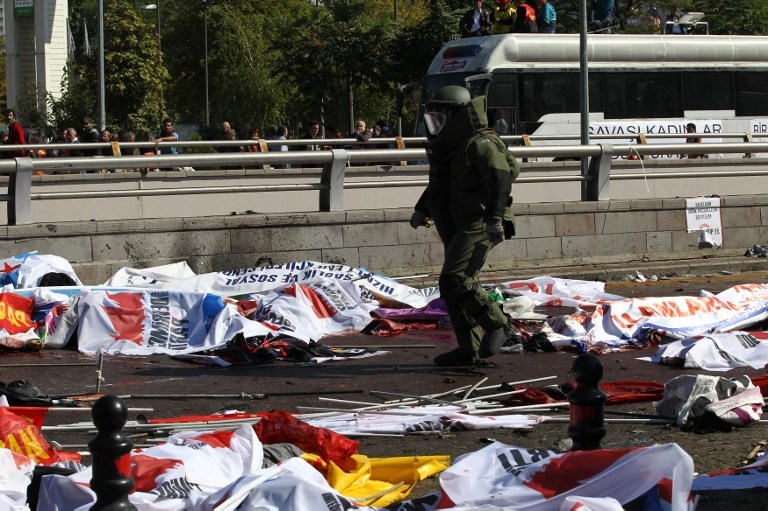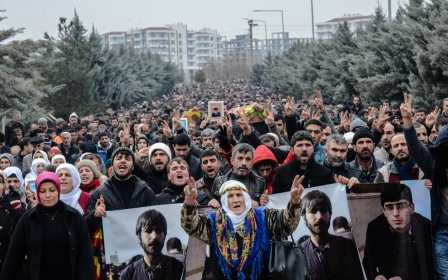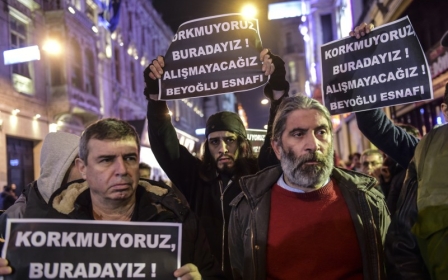The Kobane connection: IS 'tea house cell' blamed for Turkish bombing spree

ISTANBUL, Turkey - When 23-year-old Mehmet Ozturk turned the corner of Balo Sokak on 19 March and walked onto Istiklal Caddesi, the busiest street here in the capital, he was unknown to all, save the few specialists who study militant groups in Turkey.
After he detonated the explosive vest that was concealed under his clothing, killing both himself and four foreign tourists, his name was splashed on every newspaper. In scale, it may have been smaller than other recent attacks in Ankara, but here was an attack on Istiklal Street itself, one of the most prominent symbols of modern Turkish life.
The country was shocked. Or it would have been, were it not for the sheer thudding regularity with which Turkey has experienced mass casualty attacks of exactly this sort over the past year. Eight attacks in 12 months, four since January, have left 220 dead.
Ozturk was in many ways the perfect example of the modern suicide bomber. He was an introverted young man, a loner, who had always disdained popular culture and especially popular music and television.
For most of his life, he had shown no sign of religious fervour. He had avoided mosques. Then, after returning from military service, a change had come over him, his family said. Suddenly, he was telling everyone else how and when to pray.
Turkey's Interior Ministry insisted he was not on any wanted list, but in truth Ozturk was part of a small militant cell with links to the Islamic State (IS) group that investigators believe has been at the core of five separate mass casualty attacks in Turkey over the past year.
The IS cell
The Adiyaman cell, as it has become known, came to public attention after it launched attacks on the branch offices of the pro-Kurdish People's Democratic Party (HDP) in Mersin and Adana in May 2015.
The “cell” itself is small. Based originally in a tea house in a small town in eastern Turkey on the banks of Lake Ataturk Dam, it has nevertheless become highly dangerous. A number of radical clerics are associated with it, but the group is thought to be led by Mustafa Dokumaci, whom most analysts believe is operating from Syria, perhaps Raqqa itself.
“It is important to note that this is not just 30 guys sitting in a tea house in Adiyaman,” said Aaron Stein, senior resident fellow at the Atlantic Council's Middle East Centre.
“They are linked in to a far broader network that has its roots not just in Syria, but in the international jihadist movement going back to Afghanistan,” he told MEE.
Key members of the Adiyaman cell have spent time in northern Syria, especially in 2013 and 2014, but they come from a line of militant activity traceable from the mujahideen fighters in Afghanistan in the 1980s via the rise of al-Qaeda to IS. Analysts say their reach has been extended by the flow of would-be holy warriors who travel through Turkey on the way to Syria.
The cell itself appears to have followed an international trend in shifting from al-Qaeda style theology and politics to the ideology promoted by IS.
Its members believe in the restoration of a supra-national caliphate in the form of the Islamic State itself, in the general practice of salafist Islam according to one narrow school of religious jurisprudence inspired by the 13th century religious scholar Ibn Taymiyya, and in using violence to suppress other forms of Islam that it views as heretical.
In the beginning, the group explicitly and exclusively targeted the Kurdish liberation movement in Turkey. First, in May 2015 it was HDP's branch offices, then an HDP rally in Diyarbakir on 5 June. Next a member of the group named Seyh Abdurrahman Alagoz killed himself and 32 peace activists linked to the Kurdish movement in the town of Suruc on 20 July. The activists were organising for aid to be sent to the city of Kobane, then besieged by IS forces.
On 10 October, the group struck again. This time, Yunus Emre Alagoz, the owner of the Adiyaman tea house and brother of the Suruc bomber, and another unidentified assailant detonated explosive devices at a pro-Kurdish peace rally in Ankara that killed 103 people and wounded 400 others. It was the group's deadliest attack by far.
The key to this burst of violent activists from the movement appeared to be the battle for Kobane, where IS faced Kurdish forces, and the subsequent HDP/PKK riots within Turkey which saw 50 members of the Islamist Huda Par group, a party of fundamentalist Kurds that once went under the banner of Hizbullah, killed, according to Stein.
“It was then that a decision was taken to attack Kurdish soft targets and foment Turkish/Kurdish tensions inside Turkey,” he told MEE.
The Turkish government then started rounding up suspected IS sympathisers at a faster rate. But the attacks were not over; after Ankara, however, they did appear to change tactics. When followers of the group struck again in Istanbul's Sultanahmet Square on 10 January, the targets were regular tourists, as they were in Mehmet Ozturk's later bombing on Istiklal Street.
The bombing in Sultanahmet Square was an outlier in the group's record not only because the targets were tourists but also because the presumed attacker was one Nabil Fadli, a Saudi national from Syria, rather than a Turk. The group was now attacking Turkey as a whole, rather than the Kurdish movement.
Now the Turkish government appears to be taking a harsher line still with suspected IS sympathisers. On 27 March, Turkish police announced the arrest of four IS-linked individuals in Gaziantep, where Mehmet Ozturk was born. However, on 24 March, Halis Bayuncuk, also known as Ebu Hanzala, perhaps the most prominent militant preacher in the country, and one linked to the Adiyaman cell, was released from detention.
“What it looks like is that IS turned on Turkey at that time,” Stein said, noting that the Turkish government's policy towards IS sympathisers inside Turkey also switched. IS's literature also began to clearly denounce Erdogan. “They turned on Turkey because Turkey turned on them,” Stein said.
This week, Turkish police conducted raids on the Adiyaman, arresting 16 people suspected of having links to the al-Qaeda-affiliated Nusra Front, now fighting in Syria.
Kurdish militants
Although the Adiyaman cell's activity accounts for most of the bombings Turkey has endured over the past year, and most of the casualties, the group has not had a monopoly on mass political violence.
Twice this year, Kurdish militants from a group named the Kurdistan Freedom Falcons (TAK) have committed mass casualty attacks in Turkey's capital Ankara.
On 17 February, a young man named Abdulbaki Somer from the predominantly Kurdish southeastern city of Van, detonated a car bomb outside a building in Ankara that belonged to the Turkish air force, killing 30 people including both military personnel and civilians.
The attack was quickly claimed by the TAK, who in their official statement said it was carried out in “retaliation” for the Turkish army's imposition of round-the-clock military lockdowns in the predominately Kurdish city of Cizre in the Sirnak province.
Then on 13 March, the TAK struck in Ankara again. This time one of the group's members, 24-year-old Seher Cagla Demir, detonated an explosive device in Ankara's Kızılay square, a major civilian transport hub, killing 37 people.
The Turkish government was quick to place the blame for both attacks on the banned Kurdistan Workers’ Party (PKK), the armed Kurdish guerrilla movement with which the Turkish state has been in near constant conflict since 1984.
The TAK operates using traditional guerrilla tactics that were originally outlined for the PKK by one of the organisation's senior members, Duran Kalkan, based on Brazilian guerrilla Carlos Marighella's 1969 text Minimanual for the Urban Guerilla.
However, the organisation's relationship with the PKK remains cloudy. The TAK nominally splintered from the PKK in 2005, claiming the latter had become too conciliatory and “humanistic” in its approach to Kurdish liberation.
According to Ramzan Tunc, a Kurdish analyst and adviser to the pro-Kurdish Democratic Regions Party (DBP), the TAK's recent violent attacks must be seen in the context of the conflict in southeastern Turkey and the Turkish military's operations in Kurdish towns.
“There is a huge war in Turkish Kurdistan and for months it has continued now with the Turkish state attacking the Kurdish political movement and the Kurdish armed groups alike,” Tunc told MEE. “When this is happening, there will be some who believe the only response is violence.”
According to Tunc, the TAK and the PKK should be treated as separate groups. “They are quite different, with different organisational structures and different members,” he said.
“The Turkish government has a tendency to conflate all Kurdish groups, but they are not all the same. It's true there are ideological similarities between the TAK and the PKK, but that doesn't mean they're the same group: they're under totally different leadership.”
But according to Mehmet Alkis, a PhD researcher at Turkey's Marmara University who specialises in Kurdish politics in the Middle East, the relationship between the TAK and the PKK is controversial.
“Members of the TAK claim that they are a separate organisation and not under PKK control,” Alkis told MEE. “The TAK does have a distinct modus operandi and style, but in my judgement they are not completely separate either.”
At the root of the spate of political violence Turkey is experiencing, both from the Adiyaman cell and the TAK, there is a common point of departure: IS's siege of Kobane in 2014.
For Turkey’s Kurdish population, the siege created a perception that the Turkish government wanted to see the Syrian Kurdish city fall to IS which led to greater pro-Kurdish activism in the country, and then a backlash against this activism from the Turkish state.
IS's eventual defeat at Kobane also appeared to lead to increased activity from Turkey's domestic militants against the Kurdish movement.
In both cases, the horrific violence of the Syrian civil war has seeped across the border into Turkey. Initially, it was contained in the southeast, far from the centres of political and commercial power. Now it has reached the biggest cities.
Citizens of Istanbul and Ankara are learning to live with a small portion of the violence that has raged in the country’s southeast for more than a year. Some have already become stoic.
“These attacks are terrible, and they must stop, but I don't think they will,” Ahmet, the owner of a small bookshop in Istanbul's Taksim area said. “You just get on with your life.”
New MEE newsletter: Jerusalem Dispatch
Sign up to get the latest insights and analysis on Israel-Palestine, alongside Turkey Unpacked and other MEE newsletters
Middle East Eye delivers independent and unrivalled coverage and analysis of the Middle East, North Africa and beyond. To learn more about republishing this content and the associated fees, please fill out this form. More about MEE can be found here.




